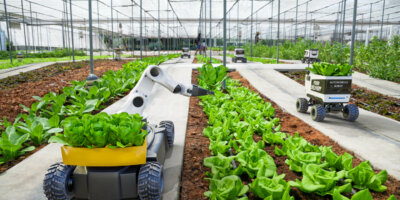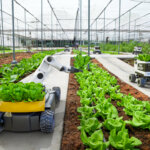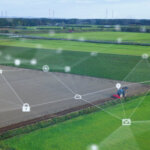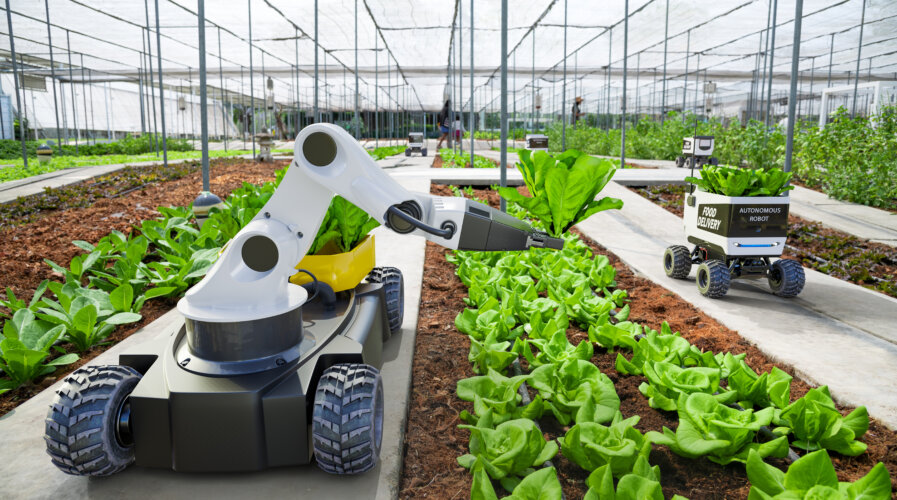
Agriculture tech at work. Source: Shutterstock.
Climate smart agriculture enabled by technology
• Agriculture tech is key to modern, efficient farming.
• Using agriculture tech can help achieve net zero.
• It can also help farmers tackle climate change.
Agriculture tech might sound like an oxymoron – at least until you look at a tractor. Even though farming and agriculture seem distanced from technology, in the face of growing demand and a need for ecologically-sound methods of producing food, tech is just the ticket. Agriculture tech has come a little way since the plow and the hoe – though those are still perfectly valid (and green) examples of farming technology.

Tools have been used in agriculture since day dot. The modern tool is tech. Source: National Geographic.
For example, only 1.2% of all water on earth is classed as usable freshwater. In fact, the amount of fresh water per capita has fallen by 20 percent in the past two decades, and approximately 60 percent of all irrigated cropland is water-stressed.
In the face of pressures arising from climate change, pollution, water policy and water-intensive industries, it is more important than ever to protect freshwater as a vital resource.
The agricultural innovations of recent decades – synthetic fertilizers, chemical pesticides and high-yield crops – have helped to increase the amount of food we can grow globally, but these inventions would all be moot without fresh water.
Agriculture specialists are under unprecedented amounts of pressure to improve operational efficiency and minimize the environmental impact of water usage. A recent report published by Viasat shows significant desire among agriculture professionals globally to enhance the industry’s environmental, social, and governance (ESG) performance, with water conservation and waste reduction being main priorities, followed closely by achieving a net zero target.
Agriculture tech to stave off climate change
The UN’s Environment Programme recently touched on the potential of “climate-smart agriculture,” and the importance of pioneering and utilizing technology which can improve the efficiency of water use and reduce pressure on global fresh water supplies. Climate-smart agriculture comprises a set of farming methods designed to increase the productivity and resilience of land, especially land affected by climate change.
While it’s not a solution to climate change, it can help to solve some of the problems that arise as a result of climate change. Balancing the operational needs of agriculture – such as crop yield and livestock production – against the need to ensure long-term environmental sustainability, however, is an ongoing challenge.
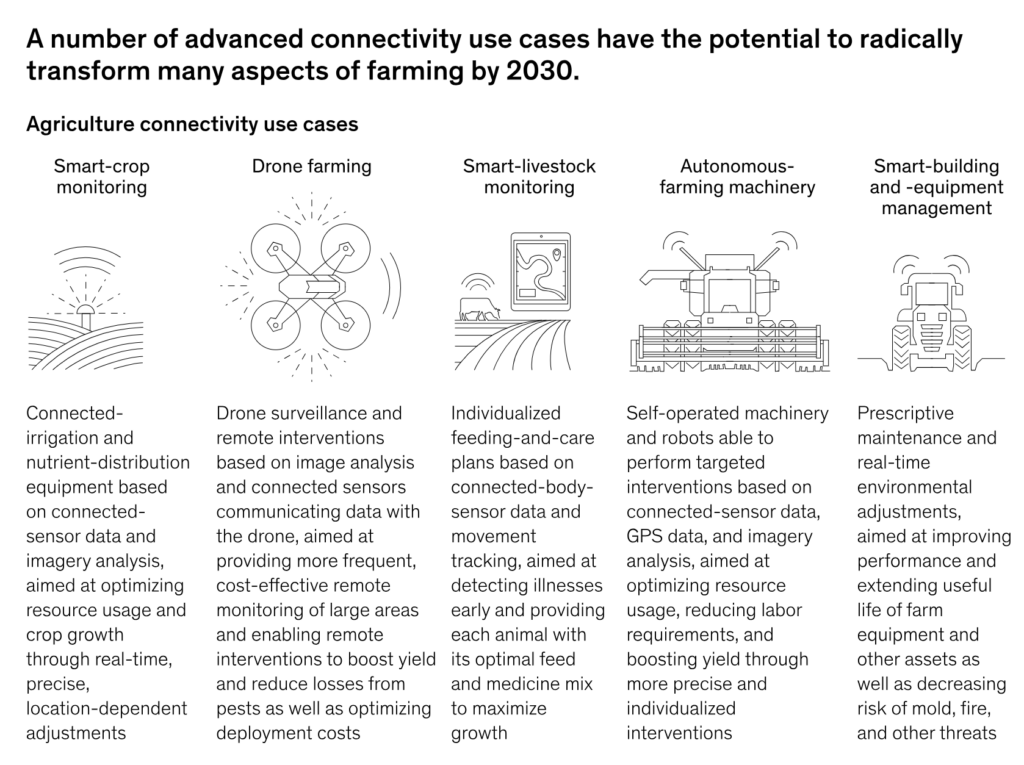
Source: McKinsey & Company. https://www.mckinsey.com/industries/agriculture/our-insights/agricultures-connected-future-how-technology-can-yield-new-growth
One potential answer to that challenge is to harness satellite-enabled internet of things (IoT) solutions. There are a multitude of applications of this technology within agriculture, and it has a lot of potential to help the agriculture industry’s net zero mission by supporting farmers and agriculture specialists to gain further insight into their operations, and to better use and manage the resources available to them.
Broadly speaking, the IoT refers to everything that is connected to the internet, but the term is also used to describe objects that ‘talk’ to one another, like smartphones, wearables and sensors. These devices can collect data for a specific purpose, and that data can be useful within a broader context. Within an industrial context, for instance, manufacturers might insert a sensor into a product or material that can monitor its condition.
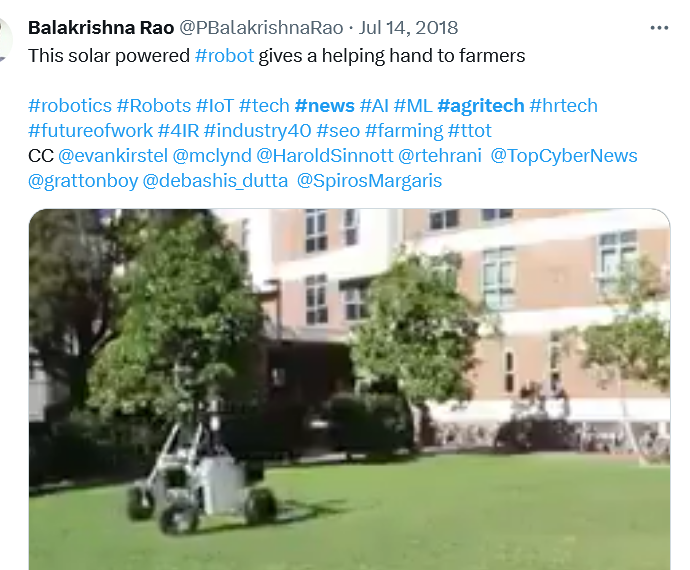
Agricultural robots could help the farming community.
With regards to agriculture, IoT-connected sensors can measure moisture levels in soil, which can provide precise and valuable insight into the conditions in which crops are being grown. This in turn lets farmers make more informed decisions around irrigation planning, which can minimize water waste and allow crops to thrive while also offering additional operational benefits, such as reducing costs arising from excessive water usage.
IoT solutions can also support smart agriculture through remote controlling. For example, Ranchbot, a provider of satellite-enabled remote water monitoring solutions, is helping to realize the benefits of the IoT on farms and ranches.
Through its two-way communication solution, farmers and ranchers can oversee their operations through applications on their mobile devices, which enable them to easily monitor water levels and control machinery (eg pumps) completely remotely. This additionally reduces travel time, saving fuel, and subsequently reducing carbon emissions.
Based on Viasat’s industry research, 71% of global agriculture tech decision makers plan to leverage IoT solutions to more accurately measure and understand the impact of their sustainability performance in the next year. 72% of agriculture firms have reported an impact from their investment in IoT solutions focused on improving sustainability outcomes, including 20% specifically seeing a reduction in their water usage as a result.
There are many options available to businesses looking to adopt IoT solutions to improve sustainability and operational efficiency, including original equipment manufacturers (OEMs), agritech companies and dealers and distributors of farming equipment.
Solutions provided by these suppliers may require some form of internet connectivity to the cloud, and access to reliable global connectivity coverage can be critical to allowing farmers in the most remote and inaccessible spots to benefit. In locations lacking in cellular connectivity, satellite provides a solution.
Many growers and livestock farmers are seeing IoT applications as a good choice to address their operational and sustainability issues. Farmers and ranchers alike benefit from having an ‘extra pair of eyes’ which can monitor and control assets and deliver invaluable oversight and actionable insights – none of which would be possible without wide-reaching, resilient satellite connectivity.
Can the IoT and edge computing help fight climate change while feeding the world?
READ MORE
- Safer Automation: How Sophic and Firmus Succeeded in Malaysia with MDEC’s Support
- Privilege granted, not gained: Intelligent authorization for enhanced infrastructure productivity
- Low-Code produces the Proof-of-Possibilities
- New Wearables Enable Staff to Work Faster and Safer
- Experts weigh in on Oracle’s departure from adland

